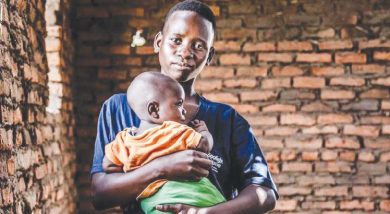Joys of family planning
Miriam Adam was 16 when she had her firstborn in 2001.
“I was angry with myself,” the mother-of-two recalls. “It was not easy to carry an unintended pregnancy at a tender age. I was safer in school. After giving birth, I started taking contraceptive pills. I didn’t want to have another baby.”
Now 32, Adam is twice as old as when the baby bulge cut-off her education at Michongwe Primary School.

birth 16 years ago
“Women bear the brunt of teen pregnancies. The man was nowhere when I dropped out in Standard Eight. I lacked care. No nutritious food. No decent clothes. No chitenje [wrapper]. I had no one to support me and the unborn baby. Yet I still had to support my brother and sister,” she narrates.
She personifies the dilemmas of most teen mothers in the country. Many girls are at risk of early childbearing.
According to the Malawi Demographic and Health Survey, about 29 in 100 sexually active young women aged 15 to 24 were pregnant in 2015.
In south eastern Machinga, girls as young as 13 marry and give birth because of poverty, indifference and social norms that enforce it.
But the pregnancies often carry substantial risks, worsen uncertainties and deepen poverty for mothers and children as men migrate to South Africa in search of better jobs.
This is why Adam eagerly jumped on a bus when her husband invited her to Johannesburg where he works.
“When he phoned me, I knew he had missed me. I got a ticket and passport ready. I didn’t want to take chances, so I went to Ntaja Health Centre where I asked a nurse to insert an implant in my upper arm. Fortunately, he understood that we did not need another baby by chance,” she narrates.
Interestingly, the two-day bus trip marked a life-changing shift from short-term contraception to the long-acting, reversible method.
The implant, tucked in her left biceps, safeguards her from getting pregnant for up to five years.
And she is at peace with it.
“Previously, I needed to swallow a pill every time I was likely to have sex. Chances of forgetting were high and I needed to replenish them frequently. Now, I go to the clinic once in five years,” she brags.
Just like that, she does not have to worry about the tragic consequences of an unintended pregnancy while her husband is toiling abroad.
Unplanned babies constitute a major cause for marriage breakdowns and unsafe, clandestine abortions among women whose husbands work in South Africa.
They often suffer humiliation, separation and name-calling, often despised as promiscuous.
The implant does not only help Adam steer clear of this embarrassment.
It also offers her more time to do business—and she makes business trips to Johannesburg where she sells usipa dry fish, beans and rice.
“When going there, I carry small things which nostalgic Malawians miss. On my return, I carry shoes, clothes and perfumes made in South Africa. This keeps me going without entirely depending on the man,” she says.
Adam counts herself lucky to be able to space her children.
“I still look younger because I have time to look after my body and have money for make-up. Some of my age-mates, who have six or seven children, look like my grannies. They cannot do business or travel to the nearest country for business because they are weighed down by their huge families. They always complain about poverty,” she says.
Almost six in ten married women in the country use contraceptives.
In 2015, United Nations Population Fund (UNFPA) pumped almost $7.1 million, from the United Kingdom’s Department for International Development (DfID), to procure family planning supplies, midwifery kits and safe motherhood drugs for even those health facilities in areas where women and girls are disproportionately affected by the unmet demand for contraceptive methods.
District family planning coordinator Elizabeth Katunga urges them to switch to long-term family planning methods.
“The uptake of family planning in the district is increasing, but the acceptance of long-acting, reversible contraceptive is still low. Only seven percent of women on contraception have long-term methods,” the nurse explains.
Besides, there is low involvement of men.
While men look away, thinking family planning is a women’s affair, they end up fathering more children than they can afford to raise responsibly.
“In Machinga, the fertility rate remains at 6.6, which is high considering that the national estimates are around 4.4 percent. This means a woman in the district is likely to have two babies more than an average Malawian woman elsewhere,” she elaborates.
Only 46 in every 100 married women in the district use modern family planning methods.
This is not only lower than the national estimates.
It is also equal to the uptake of contraceptives in the country in 2010.
But the unmet need remains high.
It is imperative to reach out to people who want to delay, space or even in some cases limit childbearing, but are not using any contraceptive method.
A recent study by reproductive health scholars at the College of Medicine in Blantyre and Guttimacher Institute in the US offers new evidence of the shocking impact of the unmet need for family planning.
In 2015, almost 470 000 pregnancies-about 53 percent of about 886 000 traced by the researchers-were unintended, ending in unplanned births, unsafe abortions and miscarriage.
“A key component to improving sexual and reproductive health and reducing the unmet need is to make the full range of contraceptive methods available, including long-acting reversible contraception which have low failure rate,” says UNFPA communications manager Henry Chimbali. n





